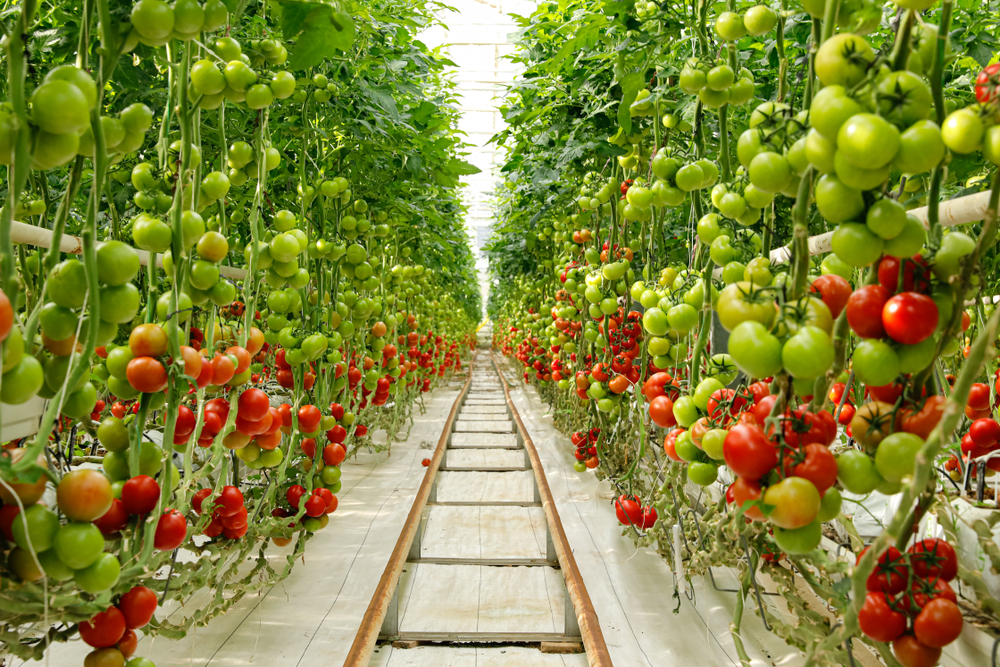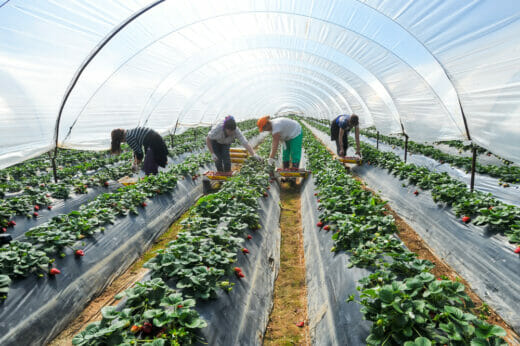Can the Heat from Running Computers Help Grow Our Food? It’s Complicated.
So-called “organic data centers” want to leverage waste heat from server farms for food production.
Can the Heat from Running Computers Help Grow Our Food? It’s Complicated.
So-called “organic data centers” want to leverage waste heat from server farms for food production.

Companies are now pairing data centers with greenhouses to reuse the heat emitted by computing hardware.by Shutterstock.
Digital technologies are changing how food is produced. And it’s more than harvesting robots that are arriving on the scene. Companies are now pairing data centers with greenhouses, capturing the heat emitted by computing hardware and reusing it to grow crops indoors.
The new QScale data center development in Lévis, Quebec is one such project. The company claims that it will “produce 2,800 tonnes of small fruit and more than 80,000 tonnes of tomatoes per year” in greenhouses to be constructed adjacent to the facility.
In promotional campaigns, QScale picks up on the growing public attention to make food systems more local amid supply chain disruptions and rising grocery costs.
As social scientists researching the environmental footprint of digital technologies, we’re interested in the potential benefits and drawbacks of this new emerging connection.
Data centers coming in hot
Every time we access content online—whether it is a video or the latest social media post—it is sent to our device by a different computer, usually located in a large data center. Also known as a “server farm,” a data center is typically a warehouse-like building that hosts hundreds of computer servers that store, process and transmit big swaths of data.
Data centers are increasingly criticized for their carbon footprint. The majority of emissions result from manufacturing the hardware they use. Servers also run day and night, continuously consuming energy and emitting heat. Backup generators guarantee uninterrupted data flow.

Temperature and humidity levels must be constantly monitored and controlled for the hardware to function efficiently and reliably. Data centers also have high water demands for cooling purposes, so they are especially contentious in dry areas.
To bring energy consumption and costs down, data center operators are increasingly looking to locate their facilities in regions with a cold climate, which often also provide access to low-priced hydropower—both are part of QScale’s sustainability strategy.
In addition, the industry is now viewing “waste heat” as a valuable resource and opportunity to increase its sustainability score. Existing examples of heat recycling from data centers include heating residential buildings and swimming pools. Now, so-called “organic data centers” propose to leverage waste heat for food production.
Agricultural land rezoned for data centers
QScale’s Lévis data center is a $867 million development, financed by both public and private capital. The Québec provincial government acts as both investor and shareholder.
The government’s investment in QScale is part of two strategic goals: supporting the province’s status as a hub for artificial intelligence (which relies on data center services and is especially energy intensive) and doubling the volume of greenhouse food production by 2025.
For QScale, pairing the data center with greenhouses is important to position itself in the public debate as “greener” and locally owned in opposition to the multinational competition.
For instance, Google’s new data center development in Beauharnois near Montréal will reportedly not include heat recycling and is also built on land originally zoned for agriculture, which is highly controversial.
When new buildings cover valuable agricultural land, they seal soil—a vital resource for long-term food sufficiency that is already shrinking due to rezoning for urban sprawl. Soil sealing means that fertile land is covered by impermeable materials like concrete.
The Québec government’s intervention to rezone the land slated for Google’s data center was heavily criticized by Québec’s farmers’ union, the Union des producteurs agricoles. The union’s spokesperson pointed out that the cultivable agricultural area is only two percent of the province’s territory.
In QScale’s case, the city of Lévis purchased farmland located next to the data center development. This land is slated to be resold to QScale or other parties to develop potential greenhouses. Through its envisioned heat recuperation for indoor agriculture, QScale aims to contribute to local food autonomy. Can this promise hold up?
Are greenhouses green?
Due to short growing seasons, Canada relies heavily on imported fruits and vegetables, especially in the winter. This dependence became clear to the public when the COVID-19 pandemic disrupted supply chains and highlighted the fragility of the global food system.
Climate change and extreme weather events pose additional challenges, which was especially evident in 2021 when a heat dome formed over British Columbia and devastating floods followed later that year.
Taking crop production out of the fields and into indoor controlled-environment agriculture (CEA) could make the domestic food system more resilient and ensure year-round access to fresh produce in Canada. Potential environmental benefits include reduced emissions from transportation and refrigeration, as well as more efficient land and water use and reduced reliance on agrochemical inputs.
However, CEA systems have high energy demands to control the temperature, humidity and lighting conditions all year round. For example, leafy vegetable vertical farms with artificial lighting consume 100 times more energy than those with natural sunlight.
Depending on the energy source of the local grid, CEA greenhouse gas emissions can outweigh their benefits. The produced crop variety is relatively small, meaning that it cannot fully cover the nutritional needs of a local population.
The economic sustainability of CEA is also open to question. It relies on venture capital investment that is currently drying up and a tech-start-up business model that may not be feasible for food production in the long run.
Who will tend to the data center greenhouse crops?
As it stands, agriculture in Canada and elsewhere relies on the low-paid, precarious work of seasonal migrants who are barred from unionizing and frequently face abuse.

Conditions in the greenhouse industry are not necessarily better. In 2021, temporary workers at Serres Demers, Québec’s largest greenhouse operator and potential partner for QScale, denounced unsanitary, crowded and dilapidated housing conditions.
While this situation has reportedly improved since it made media headlines, labor struggles for farm workers in greenhouses and fields persist.
Illusion Emploi, an advocacy organization for non-unionized workers in Québec, states that the problems at Serres Demers are representative of widespread labor issues in the industry. The organization implores the government to take action by enforcing labor standards, performing spontaneous inspections without prior notification of employers and ensuring that workers know their rights.
Complex implications
The benefits of integrating digital infrastructure and agriculture are not as clear-cut as their promoters suggest.
While recycling heat from data centers and thereby easing energy demands of greenhouses is certainly better than letting it go to waste, the complex implications of these two newly merging industries must not be overlooked.
If the continuing expansion of digital infrastructures is legitimized by adding greenhouses into the mix, it could conceal other issues at stake including the significant environmental and social impacts of hardware manufacturing, land use and labor.
Janna Frenzel is a PhD candidate in Communication Studies at Concordia University. Sarah-Louise Ruder is a PhD Candidate at the Institute for Resources, Environment and Sustainability at the University of British Columbia.
This article is republished from The Conversation under a Creative Commons license. Read the original article.
Follow us
This work is licensed under a Creative Commons Attribution-NoDerivatives 4.0 International License.
Want to republish a Modern Farmer story?
We are happy for Modern Farmer stories to be shared, and encourage you to republish our articles for your audience. When doing so, we ask that you follow these guidelines:
Please credit us and our writers
For the author byline, please use “Author Name, Modern Farmer.” At the top of our stories, if on the web, please include this text and link: “This story was originally published by Modern Farmer.”
Please make sure to include a link back to either our home page or the article URL.
At the bottom of the story, please include the following text:
“Modern Farmer is a nonprofit initiative dedicated to raising awareness and catalyzing action at the intersection of food, agriculture, and society. Read more at <link>Modern Farmer</link>.”
Use our widget
We’d like to be able to track our stories, so we ask that if you republish our content, you do so using our widget (located on the left hand side of the article). The HTML code has a built-in tracker that tells us the data and domain where the story was published, as well as view counts.
Check the image requirements
It’s your responsibility to confirm you're licensed to republish images in our articles. Some images, such as those from commercial providers, don't allow their images to be republished without permission or payment. Copyright terms are generally listed in the image caption and attribution. You are welcome to omit our images or substitute with your own. Charts and interactive graphics follow the same rules.
Don’t change too much. Or, ask us first.
Articles must be republished in their entirety. It’s okay to change references to time (“today” to “yesterday”) or location (“Iowa City, IA” to “here”). But please keep everything else the same.
If you feel strongly that a more material edit needs to be made, get in touch with us at [email protected]. We’re happy to discuss it with the original author, but we must have prior approval for changes before publication.
Special cases
Extracts. You may run the first few lines or paragraphs of the article and then say: “Read the full article at Modern Farmer” with a link back to the original article.
Quotes. You may quote authors provided you include a link back to the article URL.
Translations. These require writer approval. To inquire about translation of a Modern Farmer article, contact us at [email protected]
Signed consent / copyright release forms. These are not required, provided you are following these guidelines.
Print. Articles can be republished in print under these same rules, with the exception that you do not need to include the links.
Tag us
When sharing the story on social media, please tag us using the following: - Twitter (@ModFarm) - Facebook (@ModernFarmerMedia) - Instagram (@modfarm)
Use our content respectfully
Modern Farmer is a nonprofit and as such we share our content for free and in good faith in order to reach new audiences. Respectfully,
No selling ads against our stories. It’s okay to put our stories on pages with ads.
Don’t republish our material wholesale, or automatically; you need to select stories to be republished individually.
You have no rights to sell, license, syndicate, or otherwise represent yourself as the authorized owner of our material to any third parties. This means that you cannot actively publish or submit our work for syndication to third party platforms or apps like Apple News or Google News. We understand that publishers cannot fully control when certain third parties automatically summarize or crawl content from publishers’ own sites.
Keep in touch
We want to hear from you if you love Modern Farmer content, have a collaboration idea, or anything else to share. As a nonprofit outlet, we work in service of our community and are always open to comments, feedback, and ideas. Contact us at [email protected].by Janna Frenzel and Sarah-Louise Ruder, The Conversation, Modern Farmer
March 31, 2023
Modern Farmer Weekly
Solutions Hub
Innovations, ideas and inspiration. Actionable solutions for a resilient food system.
ExploreExplore other topics
Share With Us
We want to hear from Modern Farmer readers who have thoughtful commentary, actionable solutions, or helpful ideas to share.
SubmitNecessary cookies are absolutely essential for the website to function properly. This category only includes cookies that ensures basic functionalities and security features of the website. These cookies do not store any personal information.
Any cookies that may not be particularly necessary for the website to function and are used specifically to collect user personal data via analytics, ads, other embedded contents are termed as non-necessary cookies.
I think the answer is yes. Food production is changing as a result of digital technologies. And the arrival of harvesting robots is just the beginning. Companies are now combining data centers and greenhouses, capturing and reusing heat emitted by computing hardware to grow crops indoors.